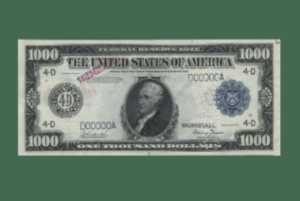Money is often weighed in financial contexts, from large-scale cash transactions to criminal investigations. Understanding how heavy Is a stack of bills is can answer practical questions and satisfy curiosity. Whether you’re considering the physical weight for shipping cash securely or simply curious about the logistics of large sums of money, this article provides a comprehensive breakdown.
Why Measure the Weight of Money?
The weight of money might seem trivial at first, but it serves practical purposes in several scenarios:
- Transporting Cash: Banks, businesses, and individuals handling large sums of money need to consider its weight to ensure safe and efficient transport.
- Law Enforcement: In investigations, weighing money is a quick way to estimate the total amount without counting each bill.
- Curiosity and Trivia: Many people are fascinated by physical money and its properties.
The Weight of a Single Bill
A single U.S. dollar bill, regardless of its denomination, weighs approximately 1 gram (0.035 ounces). This uniform weight applies to $1, $5, $10, $20, $50, and $100 bills. This standardization simplifies calculations when determining the weight of stacks or bundles of cash.
Key Facts About Bill Weight:
The weight of bills is consistent because they are printed on the same type of paper: a blend of 75% cotton and 25% linen.
The weight doesn’t vary by denomination but does vary by condition. Older, worn bills may weigh slightly less due to wear and tear.
Calculating the Weight of a Stack of Bills
Common Scenarios:
Weight of 100 Bills:

- A standard bundle of 100 bills (any denomination) weighs approximately 100 grams (3.5 ounces).
- This is equivalent to 0.22 pounds.
Weight of $1,000 in $1 Bills:

- Since each bill weighs 1 gram, $1,000 in $1 bills (1,000 bills) weighs 1 kilogram (2.2 pounds).
Weight of $1,000 in $100 Bills:
- $1,000 in $100 bills consists of only 10 bills, weighing 10 grams (0.35 ounces).
Weight of $1 Million in $100 Bills:
- $1 million in $100 bills requires 10,000 bills.
- 10,000 bills weigh 10 kilograms (22 pounds).
Weight of $1 Million in $1 Bills:
- $1 million in $1 bills consists of 1,000,000 bills.
- This stack would weigh 1,000 kilograms (2,200 pounds), the equivalent of a small car.
Summary Table:
| Amount | Denomination | Number of Bills | Weight (grams) | Weight (pounds) |
|---|---|---|---|---|
| $1,000 | $1 | 1,000 | 1,000 | 2.2 |
| $1,000 | $100 | 10 | 10 | 0.022 |
| $1,000,000 | $1 | 1,000,000 | 1,000,000 | 2,200 |
| $1,000,000 | $100 | 10,000 | 10,000 | 22 |
Practical Applications of This Knowledge
Shipping and Security
Transporting large sums of cash requires careful planning. Knowing the weight can help:
- Calculate Shipping Costs: Couriers often charge based on weight, making it essential to estimate costs accurately.
- Determine Security Measures: Heavier stacks may require specialized containers or vehicles for secure transport.
Banking and ATM Management

Banks and ATM operators handle large volumes of cash daily. Knowing the weight helps:
- Stock ATMs Efficiently: Ensuring they don’t exceed weight limits.
- Plan Cash Deliveries: Avoiding overloading vehicles.
Fun Trivia
- A stack of $1 bills totaling $1,000 would be approximately 4.3 inches high.
- A stack of $100 bills totaling $1 million would be 43 inches high (about 3.5 feet).
Other Currencies: How Do They Compare?
While the U.S. dollar is widely used as a reference, other currencies have different weights due to variations in size, material, and thickness:
- Euro Notes: The average euro note weighs about 0.98 grams, slightly lighter than U.S. bills.
- British Pounds: Banknotes in the UK weigh about 0.94 grams.
- Indian Rupee: Indian currency notes weigh approximately 0.9 grams.
Factors That Affect the Weight of Bills
- Wear and Tear: Heavily used bills may lose a fraction of their weight.
- Moisture: Damp bills weigh slightly more.
- Counterfeit Notes: Fake bills often use different materials, altering their weight.
Conclusion
Understanding the weight of a stack of bills provides valuable insights for practical applications, from shipping and security to banking operations. A single U.S. bill weighs 1 gram, making calculations straightforward. Whether you’re moving $1,000 or $1 million, knowing the physical weight helps in planning and logistics.
So, the next time you see a movie scene with stacks of cash, you’ll know just how heavy that fortune really is. Curious about other money-related trivia? Explore our blog for more insights!
